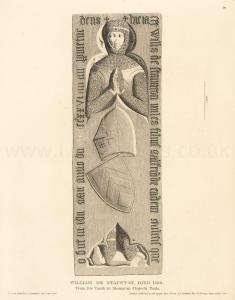Effigy of Sir William de Staunton
Effigy of Sir William de Staunton is in Monumental Effigies of Great Britain.
THIS singular tomb in Staunton Church, Nottinghamshire, commemorates Sir William de Staunton. This family, who took their surname from the spot where they were settled and had possessions, are said to have nourished there before the æra of the Norman Conquest. A rhyming herald of the sixteenth century, speaking of them, says,
"The first Sir Mauger Staunton, Knight,
Before Wiiiiam came in-"
They held their lands at Staunton by tenure of castle guard of the Lords of Belvoir. There was a tower in that fortress [Map] called Staunton Tower, which they, by obligation of the tenure no doubt, built and kept in repair. Sir William was the son of Sir Geoffrey de Staunton and Alice his wife. He was a knight of active reputation, favoured by Edward I and employed in his service. He made his will in 1312, and from it we may gather that he was under a vow of pilgrimage to the Holy Land, for he left a bequest of five marks each to two footmen who should go "the first passage," in his name. He died in 1326. The monumental stone of Sir William de Staunton is somewhat fanciful; it appears intended to represent him lying in his coffin, the lid of which is cut away to show the figure as far as the elbows, and the feet to the ancles. On the centre of the stone is his helmet, and his shield with two chevronsa. Round the edge of the stone runs the following inscription in the black letter character, being an early instance of its adoption.
Hic jacet Will's de Staunton miles filius galfridde eademb militis que obiit in idu maii anno d'ni......CCXXVI cui' an .. p'picietur. On that part of his surcoat visible, the upper of the two chevrons appears.
Note a. A seal of his Father Geoffrey, appendant to a charter, bears two bars and a!arge canton, charged with a mullet of six points. His son, it appears, adopted another coat: his seal, as well the tomb, exhibits the two chevrons. Legend, s . WILL . DE . STANTON . MILITIS.
Note b. Blundered for Galfridi ejusdem, as also que for qui, the second following word.
